
It allows to keep PV going, with more focus towards AI, but keeping be one of the few truly independent places.
-
@Sidhho To my knowledge, NLE's will not expand Studio Swing 16-235 streams into Full Swing 0-255. The behind-the-scenes conversions always produce Studio Swing streams, not the reverse.
Contrary to what @towi claims (and has yet to provide any tangible evidence to back up), the GH2's histogram displays are not literally recorded into the MTS files. While intuitively appealing, this speculation is disproven by examing the range of the luma signals encoded in the files. If you'd like to see for yourself, please download the MTS file I linked at the top of this page. While the GH2 does use Rec. 709 color primaries (i.e sRGB), it encodes Full Swing luma components, much like Canon and other DSLR's.
As I've pointed out to @towi, as long as you remain within the default Studio Space environments of Avid and Vegas editors, your files will be automatically converted into its 16-235 range, regardless of what they originally contained. If this is what you prefer, and you like the results it produces, you can choose to remain safely within that NTSC broadcast-constrained world.
-
-
"please download the MTS file that I posted last week at the top of this page, it contains the smoking gun you're looking for"
Just registered at Vimeo to finally look at your file.
First attachment shows the MTS file imported into Avid while preserving the original levels (without any remapping - please note once and forever: Avid does not apply any "under the hood" remapping unless you explicitly choose to do so)
Second attachment shows the MTS file converted through "Media Converter" (which utilizes FFmpeg) to QT DNxHD. Imported into Avid without remapping levels
Third attachment shows the MTS file re-wrapped through ClipWrap to QT H.264 and opened via "AMA" in Avid ... the attachment shows the import menu (prior to actually importing the file) and the source file's histo (vertical bold lines show 16-235 Y' range)
Fourth attachment shows the MTS file converted through 5DtoRGB ("luminance range" set to "full range" to maintain all the levels that live within 0-255) to ProRes HQ and opened via "AMA" in Avid ... the attachment shows the import menu (prior to actually importing the file) and the source file's histo (vertical bold lines show 16-235 Y' range)
Fifth attachment shows the MTS file converted through Cineform "NeoScene" to CFHD and opened via "AMA" in Avid ... the attachment shows the import menu (prior to actually importing the file) and the source file's histo (vertical bold lines show 16-235 Y' range)
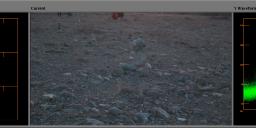
 Avid_orignal_levels.jpg1920 x 408 - 236K
Avid_orignal_levels.jpg1920 x 408 - 236K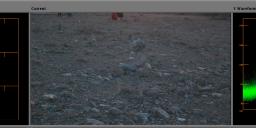
 MC_ffmpeg_Avid.jpg1920 x 410 - 243K
MC_ffmpeg_Avid.jpg1920 x 410 - 243K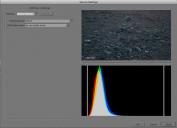
 ClipWrap_AMA.jpg949 x 687 - 136K
ClipWrap_AMA.jpg949 x 687 - 136K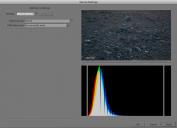
 5DtoRGB_AMA.jpg948 x 687 - 135K
5DtoRGB_AMA.jpg948 x 687 - 135K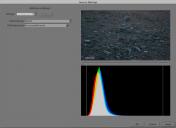
 Cineform_AMA.jpg947 x 689 - 136K
Cineform_AMA.jpg947 x 689 - 136K -
"As I've pointed out to @towi, as long as you remain within the default Studio Space environments of Avid (...) editors, your files will be automatically converted into its 16-235 range, regardless of what they originally contained"
As long as Avid is concerned - sorry, this is utter BS. Please stop talking about software you don't know.
"Isn't it about time you provided some hard evidence to back up your unproven assumptions?"
All you've provided by now is how AE reads the file. Great!
-
@towi As your histograms indicate, you've chosen a largely gray frame that contains virtually no white or black luma components. This doesn't prove your point since there's nothing to display anywhere close to 235.
In addition, much of your workflow is relying on QuickTime and/or ProRes conversions that could also introduce Rec. 709 color space remapping. At any rate, the DNxHD, H.264, and ProRes frame grabs you posted are not direct evidence of the contents of the original MTS file, they are transcoded renderings!
According to this article, Avid continues to work in a Studio Swing 16-235 color space, even if you choose to bypass its automatic color space conversion:
http://terburg.home.xs4all.nl/Publications/601_709_RGB.pdf
"Note that the Avid is a video editing application, and is supposed to work in video color space (601/709). So the Avid codec always assumes you are going to end up with something that is supposed to be 601/709 compliant (ergo 16-235)."
That's correct, is it not? Is it not true that Avid's internal black level is always set to 7.5 IRE?
-
@towi you beat me to it, I found nothing under 16 either. However, looking at it with Color Finesse on Premiere (as @lpowell was running in the first example) the histograms there definitely show the range minimum as being zero in all channels. I guess Premiere and/or Color finesse is remapping, which is okay, but could explain the confusion.
@lpowell I use Nuke, pretty much exclusively for all image processing, everything I do is in linear space so I'm well aware of the benefits. But I can still produce posterisation with footage with a low dynamic range by performing similar actions to your pedestal adjustment (especially with low light/low range footage). You can also do it with Premiere too. Moving into a 32 bit space does not overcome the limits of your source footage (er.. rounding errors as you put it), it prevents generational degredation and also makes the integration of footage from many different sources well.. possible (was going to say easier).
Edit : you'll notice the posterisation when you do something else, like a large level adjustment, do the same adjustment without the pedestal correction and you'll see its much better. This is basic stuff to do with dynamic range.
Oh and I'm out of this discussion, its become completely circular now.
-
"That's correct, is it not? Is it not true that Avid's internal black level is always set to 7.5 IRE?"
NO, NOT TRUE ... as I've said numerous times in this thread. I've posted the quoted PDF to make this very clear: Avid's import setting "rec709" simply means: "no remapping applied". (Avid EXPECTS legal rec709 footage... this is why the "rec709" import settings means: "do nothing, the footage is ok").
Page 1 of the quoted PDF:
"I’d recommend reading the ‘RGB’ and ‘601/709’ options as follows:
IMPORT:
RGB: Remap 0-255 levels over 16-235 video (blacks lifted, whites reduced)
601/709: Do not remap (keep levels as they are)"
Avid's INTERFACE black is at 16 Y'. Likewise Avid's Title tool will create blacks at 16 Y' and whites at 235 Y'. Too, if you add a blank space in a sequence (timeline) it will be at 16 Y'. But if you import a file containing 0-255 Y' levels Avid will show all the 256 levels of the original file. See attachment (on the left a JPEG containing a ramp from 0-255 imported with said "rec709" setting).
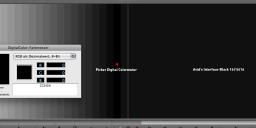
 fullswing_import_rec709.jpg1566 x 489 - 68K
fullswing_import_rec709.jpg1566 x 489 - 68K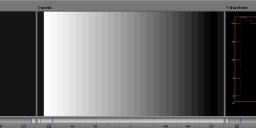
 fullswing_import_rec709_2.jpg1920 x 441 - 67K
fullswing_import_rec709_2.jpg1920 x 441 - 67K -
"As your histograms indicate, you've chosen a largely gray frame that contains virtually no white or black luma components. This doesn't prove your point since there's nothing to display above 235 anyway."
here, mate... end of the clip contains white, see attachment (the blacks alone say everything about the levels. That you are asking also for the whites tells me that you really don't understand what rec709 actually is and how it works. Wikipedia is your friend...).
"much of your workflow is relying on QuickTime and/or ProRes conversions that could also introduce Rec. 709 color space remapping"
Typically QT conversions expand levels to fullswing (at least they add flags for VIEWING purposes... the conversions do not necessarily really alter the levels of the actual file). In a consistent workflow you can avoid such adulterations, of course. Besides I've used softwares that do NOT use QT's engine for the conversion. Cineform NeoScene and 5DtoRGB use their own engines, "Media Converter" utilizes "ffmpeg". Not quite sure about ClipWrap, though.
"they are transcoded renderings!"
Yes, but they all do exactly match the import of the native MTS file into Avid ... and I bet they also match the RGB histo on the GH2 when you playback the file in-camera.
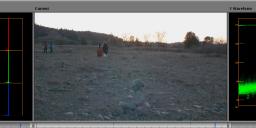
 whites.jpg1920 x 426 - 247K
whites.jpg1920 x 426 - 247K -
@LPowell - "That's correct, is it not? Is it not true that Avid's internal black level is always set to 7.5 IRE?"
@towi - "NO, NOT TRUE ..."
@towi "...Avid's INTERFACE black is at 16 Y'. Likewise Avid's Title tool will create blacks at 16 Y' and whites at 235 Y'. Too, if you add a blank space in a sequence (timeline) it will be at 16 Y'."
When I refer to Avid's internal black level, I'm not talking about its file import options. What concerns me is that regardless of how you choose to import your files, Avid operates with its black level set to 7.5 IRE (i.e. 16 Y'). The examples you noted above confirm that 7.5 IRE is in fact Avid's fixed black level (and there is no option to set Avid's internal black level to 0 IRE). Here's a link from Avid's Knowledge Base that confirms that this is the way Avid is designed to work:
http://avid.custkb.com/avid/app/selfservice/search.jsp?DocId=216429&ssdFilterCommunity10=368&ssdFilter_SearchKeyWord={0}%2Cpinnacle+site%3Awww.avid.com%2FUS%2Fsupport%2Ftraining&Hilite={0}%2Cpinnacle+site%3Awww.avid.com%2FUS%2Fsupport%2Ftraining
Your attempts to obfuscate this basic fact with diversions into QuickTime, NeoScene and 5DtoRGB transcoded workflows are irrelevant. And what you apparently fail to understand about After Effects is that it provides comprehensive Color Manangement options via ICC Profiles that control not only file import, but the reference levels of its internal color space as well. From among numerous built-in profiles, this enables you to select whether each project operates in either of these two standardized color spaces:
- Rec. 709 Studio Swing (16-235) Black Level: 7.5 IRE
- Rec. 709 Full Swing (0-255) Black Level: 0 IRE
Depending on which profile you assign to each project, After Effects will import video files into that selected color space based on the color space profile that is embedded in each file. If the file's profile matches the project's profile, it will be imported without remapping its color space. With GH2 MTS files, that is what happens when you select Rec. 709 Full Swing as the project profile. If you instead select Rec. 709 Studio Swing as the project profile, AE will detect that the file's color space doesn't match, and will remap it into the Studio Swing color space.
Below are examples of the color spaces that After Effects uses in Studio Swing and Full Swing Profiles. Note that if the MTS file's embedded profile (Rec. 709 Full Swing) had been incorrectly identified by After Effects, the file imports would not have produced the correct 16-235 waveform in Studio Swing and the correct 0-255 waveform in Full Swing color spaces.
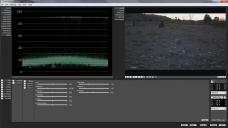
 Studio Swing Levels.jpg1280 x 720 - 261K
Studio Swing Levels.jpg1280 x 720 - 261K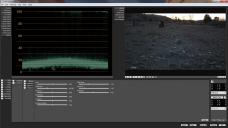
 Full Swing Levels.jpg1280 x 720 - 271K
Full Swing Levels.jpg1280 x 720 - 271K -
"When I refer to Avid's internal black level ..."
as you obviously don't know anything about Avid, about Avid's black level and obviously nothing about rec709 you should stop fantasizing about it. It is slowly becoming embarrassing. The knowlegde base article you've quoted referrs to Pinnacale Studio (which is a consumer software aimed at DVD creation or so... I don't know the software).
"And what you apparently fail to understand about After Effects is that it provides comprehensive Color Manangement options via ICC Profiles that control not only file import, but the reference levels of its internal color space as well"
I bet this is completely wrong. But as I don't know AE I can only speculate about it. What happens to the footage in the first attachment ("studio swing levels") when you add a curve to lower the blacks to 0 Y'? Does your "internal color space" work like a "limiter" (cutting off all levels below 16 Y' and above 235 Y' either way how you color correct the footage)? How would you create for instance rec709 compliant movies containing super blacks with AE then? (Besides you should not talk about "ICC" profiles...).
Anyway ... in any case Avid's black level does not work like a "limiter" - you can easily create blacks at 0 Y' and whites at 255 Y'. Of course you can also preserve the levels of the original file on import (either way wether the imported file utilizes fullswing or studio swing). Both has been proven in my examples posted above. So your assumtion "Avid operates with its black level set to 7.5 IRE" is plain and simply wrong here.
"Below are examples of the color spaces that After Effects uses ..."
cool, we've already seen this. All you can provide is how AE treats MTS files (based on import settings you have selected). This is what you call "hard evidence"?
-
@towi "This is what you call "hard evidence"?"
Yes, and like many who insist on maintaining standards that have outlived their former usefulness, you're determined to reject it with as much disrespect as you can muster. Since you've nothing but insults to offer at this point, I'll take that as confirmation that Avid does indeed work exclusively in Studio Swing's broadcast-restricted color space.
-
"like many who insist on maintaining standards that have outlived their former usefulness, you're determined to reject it with as much disrespect as you can muster"
I've never stated that I "like" or "dislike" the standards. I was only talking about the levels the GH2's MTS files contain.
In fact I would appreciate if the GH2 would encode it's MTS files into fullswing - we would get rid off the histo-squeezing and we could use a decent LCD preview while shooting. Above all - and most importantly - we would (most likely) get rid off the GH2's banding issue (my take on this: the GH2's sensor of course shoots fullswing, just as in photo mode. But somewhere down the pipeline the video files get compressed into studio swing in 8bit mode. So I assume the GH2's banding is simply a result of the internal fullswing->studio studio swing conversion). Canon does it right in this regard, IMHO - when you use a photo-camera for shooting video the video mode should work exactly as the photo mode. Unfortunately the GH2 does not.
So now we are maybe back on topic... a hack that enables the GH2 to encode its MTS files in fullswing would be phantastic!
edit:
"... Avid does indeed work exclusively in Studio Swing's broadcast-restricted color space"
Incorrect. Repeat: incorrect.
And: there is no such thing as a "broadcast-restricted color space" that limits the luminance levels (at least not in Avid ...). Rec709 by definition contains the full range of 0-255 Y'. 16-235 Y' is utilized for actual image content while levels below 16 Y' and above 235 Y' provide footroom and headroom (for instance can be used for super black keys). A "color space" that acts like a "limiter" / "legalizer" would cut off all the footroom and headroom. For beginners: http://en.wikipedia.org/wiki/Rec._709
So... back to topic... a hack that enables the GH2 to encode its MTS files in fullswing would be phantastic!
-
In fairness guys, this heated discussion is a really good demonstration about why studio levels suck suck suck. I guarantee you that a massive amount of people working in video don't fully understand all the implications, or exactly how their software handles it - even if they think they do. It's not because we're stupid, but because the whole issue is absurdly complex.
I have programmed my own effect for Premiere, so I know a little about how it works there. From an effect's point of view, it can request the pixel format(s) it wants to work in. Some formats are full swing, some in studio levels (all documented). Premiere will internally convert the frame to the most suitable format the effect supports before handing it to it (and convert it again if needed for other effects, display or exporting). It presumably picks formats that will require the least damaging conversions.
So it's the effect's job to handle these formats correctly. If it performs gamma correction with a studio-levels format, it needs to handle that correctly. However I would then expect it to assume the blacklevel is 16 - so if there are useable super blacks (or whites) you want to preserve correctly, that does require manual intervention (if you care).
What I'm also not 100% sure about is how Premiere imports the footage. Logically (and I'm pretty confident this is what actually happens), Premiere will important studio level footage as-is. This is because (as ways pointed out), super-blacks and whites are part of the standard, and so should be preserved. So it makes no sense for any NLE to clip anything off unless it has to convert to full-swing 8bit RGB at some point.
And with Premiere that can happen in unintuitive ways - if you have any effect on your clip that only supports 8bit RGB, then Premiere has to expand the studio range (and clip off the supers) while the frame is being processed. So to avoid that, stick to YUV or float capable effects.
Finally, just because there seem to be clear rules of how formats are handled, doesn't guarantee they always are correctly. For example, there seems to be a known issue where some versions of Premiere import some rec709 footage as rec601 - that's a different issue (it just means that the colour & gamma are slightly off), but the point is that bugs exist everywhere, and even if many codecs import exactly as advertised, there might be the odd bug in a specific file format. So it's all a minefield really.
Bottom line, kill off studio levels & interlacing and this whole legacy mess goes away. That will probably take many years though (sigh), especially while new cameras are still coming out with interlaced video modes (WTF?).
-
I say we burn the witch!
-
@towi Since you've sunk to the level of personally insulting and trolling me, I consider your further interest in this topic as nothing more than inflammatory provocation.
-
Thanks for this great FlowMotion patch! Really impressed with it. I've been absent a long time dealing with medical issues but have been watching the board with interest. Nick's work with Intra has simply been staggering. And BKWCMD's latest 3GOP work great as well, along with all the other tireless testers. And of course, Vitaly should have his hand prints enshrined in the concrete on Hollywood Blvd. Kudos to all. It seems like such a short while ago that the whole low GOP concept was heresy. Flames were flying, and some of us were constantly ready for a street fight to defend the low GOP notion. Now that it's become universally accepted, I have to say, I'm still attracted to 3 GOP as the 24H solution for me personally. I have tried a lot of Nick's incredible intra patches and they're amazing. But for me the motion capture isn't recognizably different from 3 GOP so the bandwidth required for like quality isn't worth it to me. Also, the headlong march into high detail has moved the resulting images further away from a 'film look' to me. It's totally subjective, I know, but to my eye the higher detail has lead to even greater depth of field because everything, even deep background becomes sharp, and that's what I'm trying to get away from. Which brings me to your patch...
It's the closest thing I've found to the early 65MBExtreme settings that I still love for film look. Of course, those settings don't work on 3.64 (maybe you can give me pointers as to why). But your Flowmotion patch does even better giving consistent 54mbs data streams on normal footage with an even better I frame to B frame ratio than the 65 extreme patch did. I also think the Flowmotion patch renders the highlights incredibly well. I do find the auto focus on the 14-140 a bit slow with this patch, it's weird how some patches affect autofocus, but I can live with it.
Question: Is there any way to get the ability to set the detail level by ticking the AQ 0, 1, 2, 3 or 4 settings again like we could in 3.63? I loved a lot of Nick's patches with the AQ set to 0 but didn't like them at 4. Now I can't seem to make that mod because of all these new 'matrixes'. Is there a way to up or lower the detail with your new patch? I ask because the 14-140 is very sharp so stock is fine, but some of my FD lenses are softer so I'd like a little more detail. I guess I could turn up the sharpness, but I've always been averse to that.
Again, thanks for the patch.
-
"Since you've sunk to the level of personally insulting and trolling me, I consider your further interest in this topic as nothing more than inflammatory provocation"
it is of course very easy to stop the dispute this way. naturally it would have been much harder for you to openly admit a mistake. So be it…
-
The man is going in for surgery, perhaps we should wish him well?
-
I thought this was the thread for FlowMotion settings ?
-
Since I don't know anything about this I feel free to chime in :) I think it is reasonable to ask for actual examples. Sending material through intermediate codes like cineform, prores, etc proves nothing. Also, why would anyone resample the video to prove a point? I think lpowell's example is very interesting.
As for Avid, there is this quote from their website (and this is not Pinnacle, but Avid) From the horse's mouth: "Since we make video systems, we normalize everything inside our systems to the video standard of 16-235, but you need to tell us which format you are providing when you import, so we can normalize correctly." http://goo.gl/1C0gR Of course they could be mistaken. After all, over a period of years software goes through many designers. I suggest someone who owns the software send them an email asking if they really do that.
-
"Sending material through intermediate codes like cineform, prores, etc proves nothing"
Correct. My first example referred to direct import of the actual MTS file into Avid (without conversion prior to import). I've then used 4 other softwares to illustrate that the respective files of all those 4 softwares show exactly the same levels as Avid, regardless of the codec used. (And exactly the same levels as the GH2 itself on the RGB histo in playback mode.)
Look, it's very easy. Some simply see a "strange" behaviour of the GH2 while shooting video (histo-squeezing / LCD with crushed blacks + whites / RGB histo in playback mode does not show the full range of levels from 0-255, while it does in photo mode, of course). But for some the GH2's behaviour makes sense as they see exactly the same levels in their editing software (in other words: consistent levels from shooting to editing). Choose whatever you prefer ...
-
Hello, what is your patch works best?
-
I think, that when lpowell posted this "Basically, what my recommended pedestal adjustment does is crush the noise and artifact-contaminated bottom end of the sensor's range into solid black..." That it means he's saying now that the artifacts have nothing to do with the interpretation of the footage by the application, and/or a result of the GH2 producing RGB values under 16 (it doesn't). Which is contrary to what he initially said, and its what he initially said that made me question his premise.
Also, his description of what the pedestal adjustment is doing "The luma components that lie just above that threshold are legitimate image details and the pedestal adjustment fades them gradually, rather than raggedly, into black." Isn't true, its basically clamping (shifting your whole range) which is, to me, while being a valid approach, is not the best approach to take for dealing with those kind of artifacts. There is nothing 'gradual' going on. You don't want to shift your entire range to fix blocking artifacts. There is nothing gradual about a pedestal adjustment, it seems to me to be no different to the old analog video days of turning the knob on the luminance black level of a proc amp. Matching footage from the same shoot that you don't make a pedestal adjustment on, because there are no dark blacks, or artifacts within them, will be a PITA. Adjusting the gamma post pedestal adjustment as he recommends will not help this, as that can create even more problems now that the range has been dropped.
-
@feha this thread has been completely screwed up.
-
@LPowell, @Stray, @Towi. All three of you are professionals and subject matter experts in your field. You have your own preferences, your favorite software to work with and your way of doing your work. You are all correct and nobody is wrong. Do what works for you and let's move on and no more posts on the editing and color correction since this thread was about a great setting called FlowMotion. If you like to continue this discussion, please start a new thread so the rest of us do not have to see that. Let's focus back on the FlowMotion settings and updates for the new matrix, because I think it is one of the best all around settings. i apologize in advance if I offended anyone.
Howdy, Stranger!
It looks like you're new here. If you want to get involved, click one of these buttons!
Categories
- Topics List23,993
- Blog5,725
- General and News1,354
- Hacks and Patches1,153
- ↳ Top Settings33
- ↳ Beginners256
- ↳ Archives402
- ↳ Hacks News and Development56
- Cameras2,368
- ↳ Panasonic995
- ↳ Canon118
- ↳ Sony156
- ↳ Nikon96
- ↳ Pentax and Samsung70
- ↳ Olympus and Fujifilm102
- ↳ Compacts and Camcorders300
- ↳ Smartphones for video97
- ↳ Pro Video Cameras191
- ↳ BlackMagic and other raw cameras116
- Skill1,960
- ↳ Business and distribution66
- ↳ Preparation, scripts and legal38
- ↳ Art149
- ↳ Import, Convert, Exporting291
- ↳ Editors191
- ↳ Effects and stunts115
- ↳ Color grading197
- ↳ Sound and Music280
- ↳ Lighting96
- ↳ Software and storage tips266
- Gear5,420
- ↳ Filters, Adapters, Matte boxes344
- ↳ Lenses1,582
- ↳ Follow focus and gears93
- ↳ Sound499
- ↳ Lighting gear314
- ↳ Camera movement230
- ↳ Gimbals and copters302
- ↳ Rigs and related stuff273
- ↳ Power solutions83
- ↳ Monitors and viewfinders340
- ↳ Tripods and fluid heads139
- ↳ Storage286
- ↳ Computers and studio gear560
- ↳ VR and 3D248
- Showcase1,859
- Marketplace2,834
- Offtopic1,320










